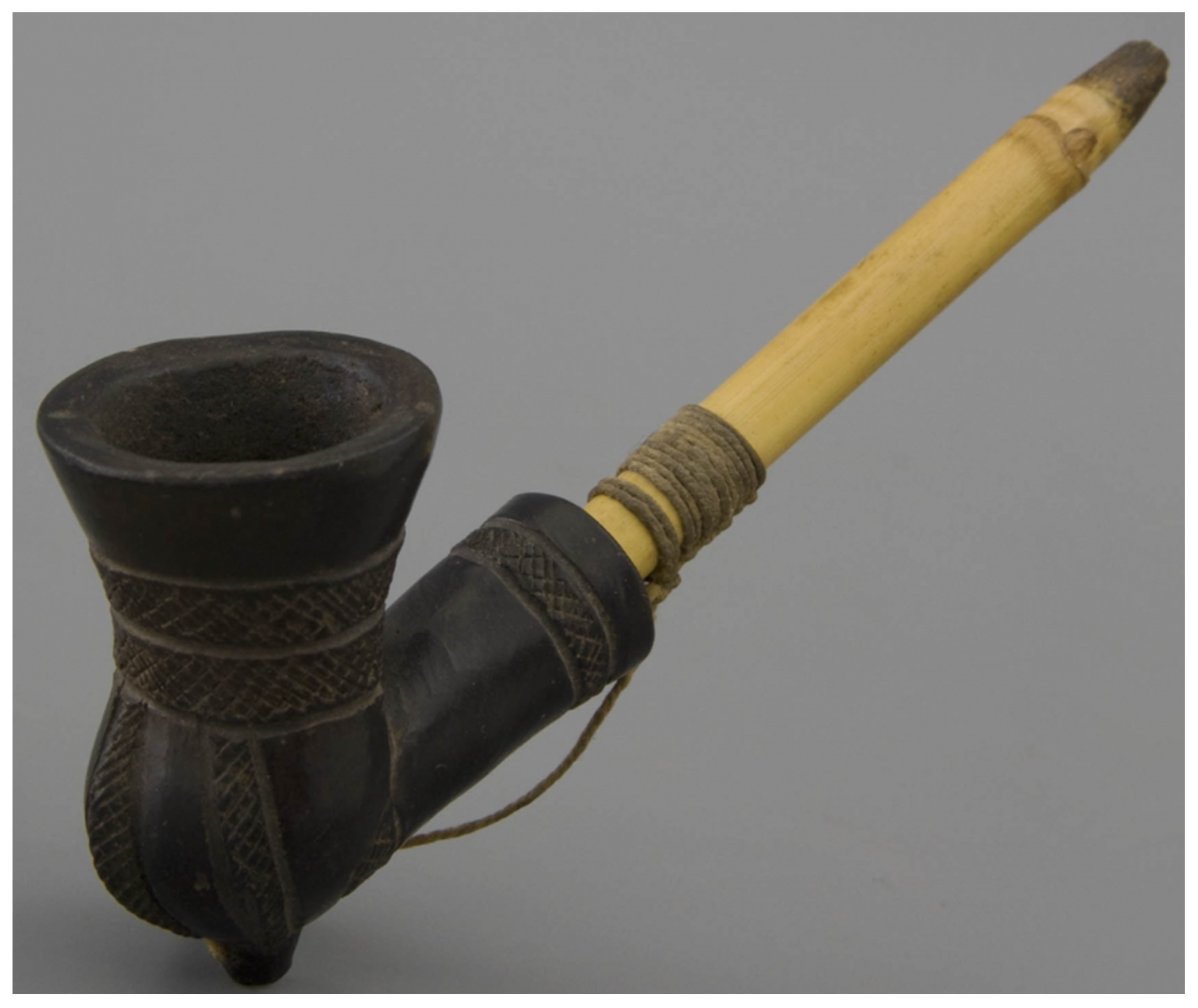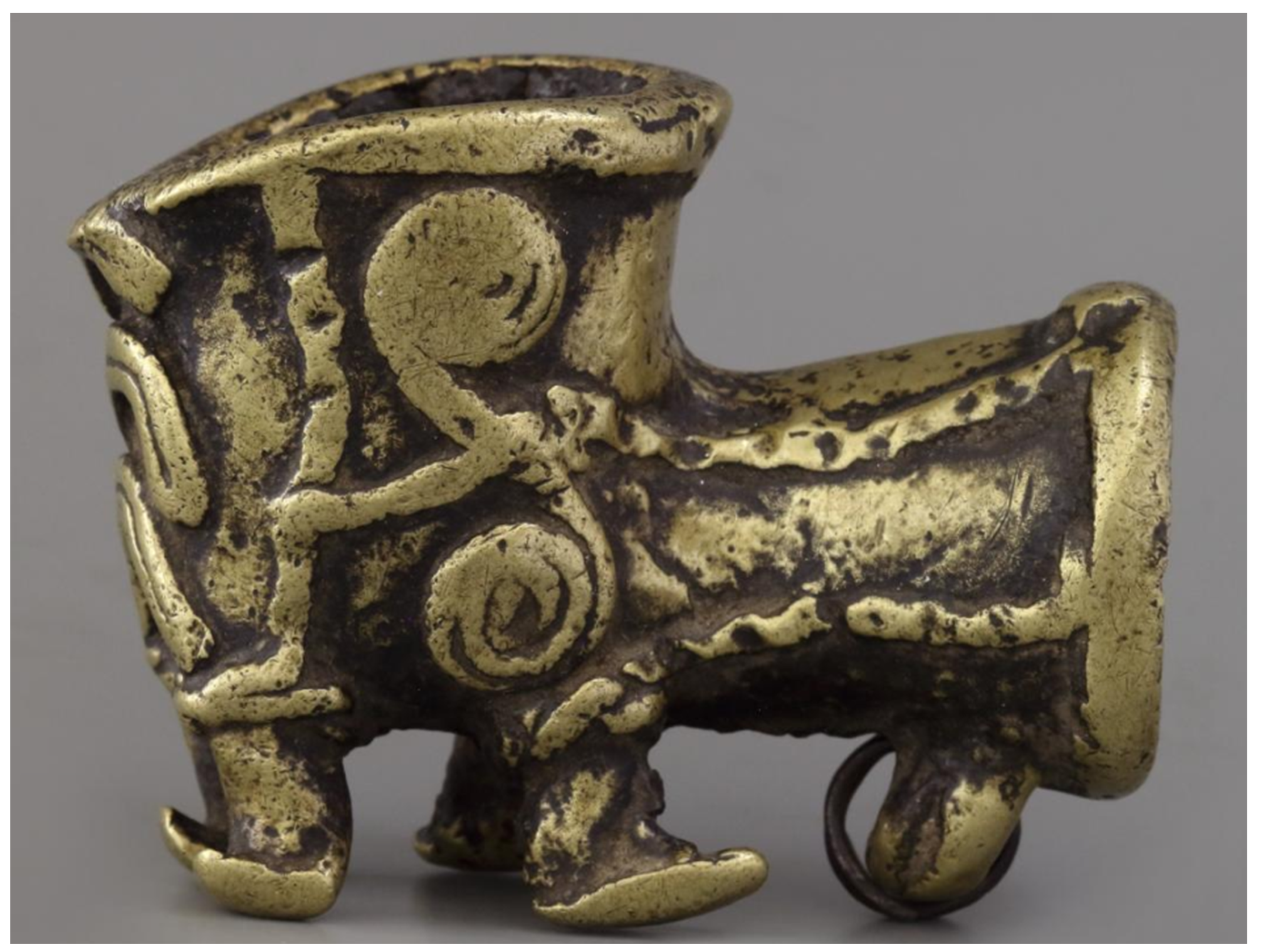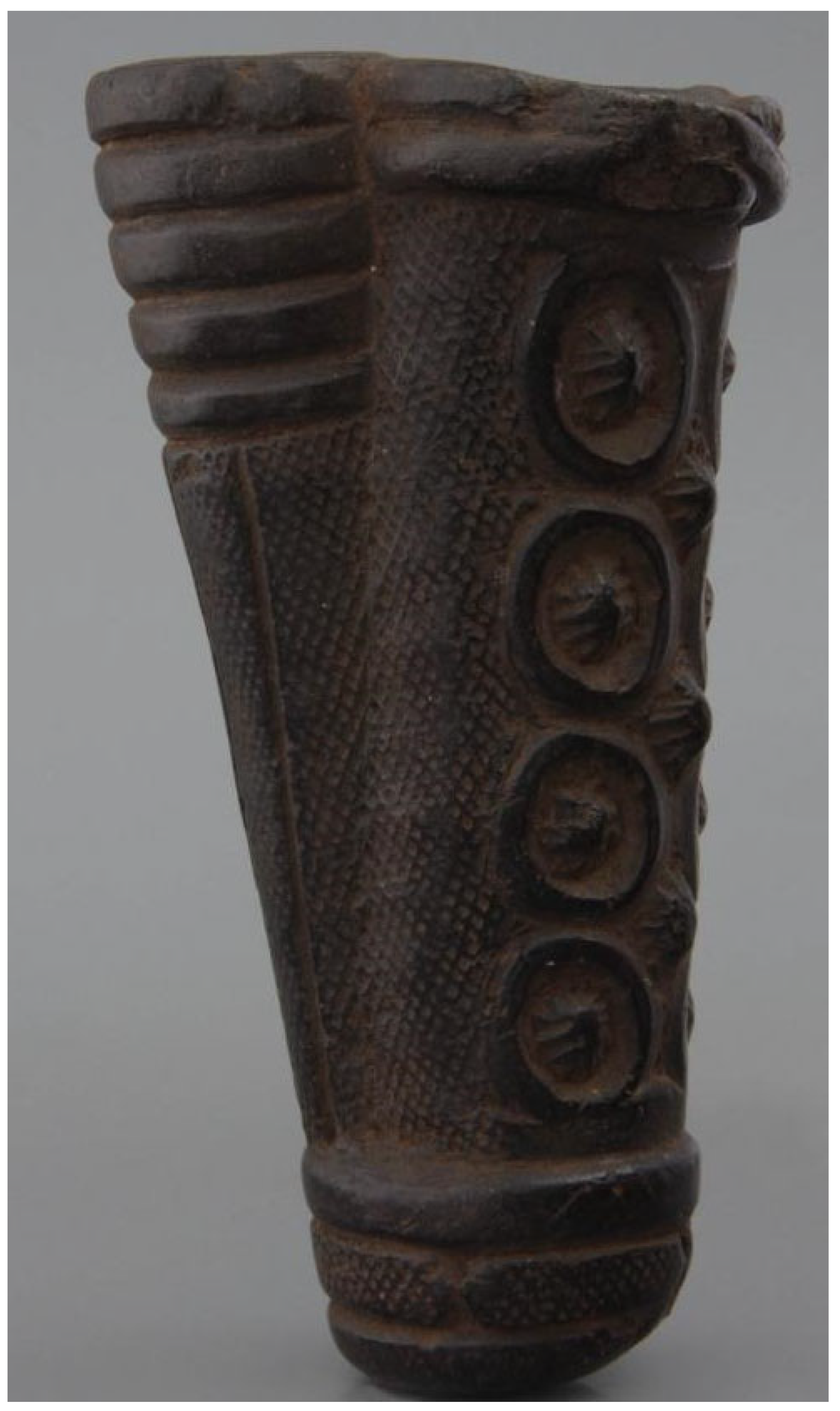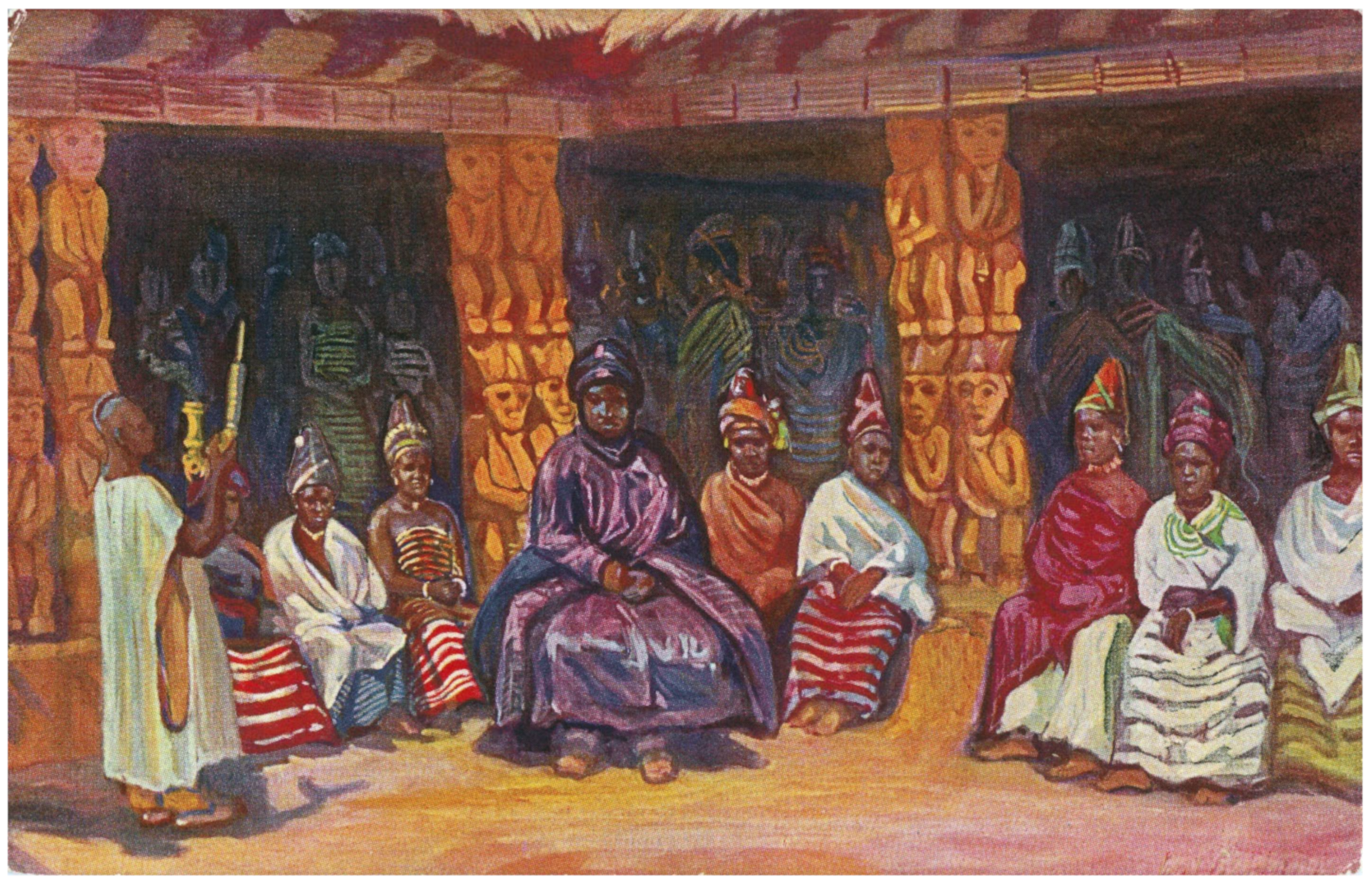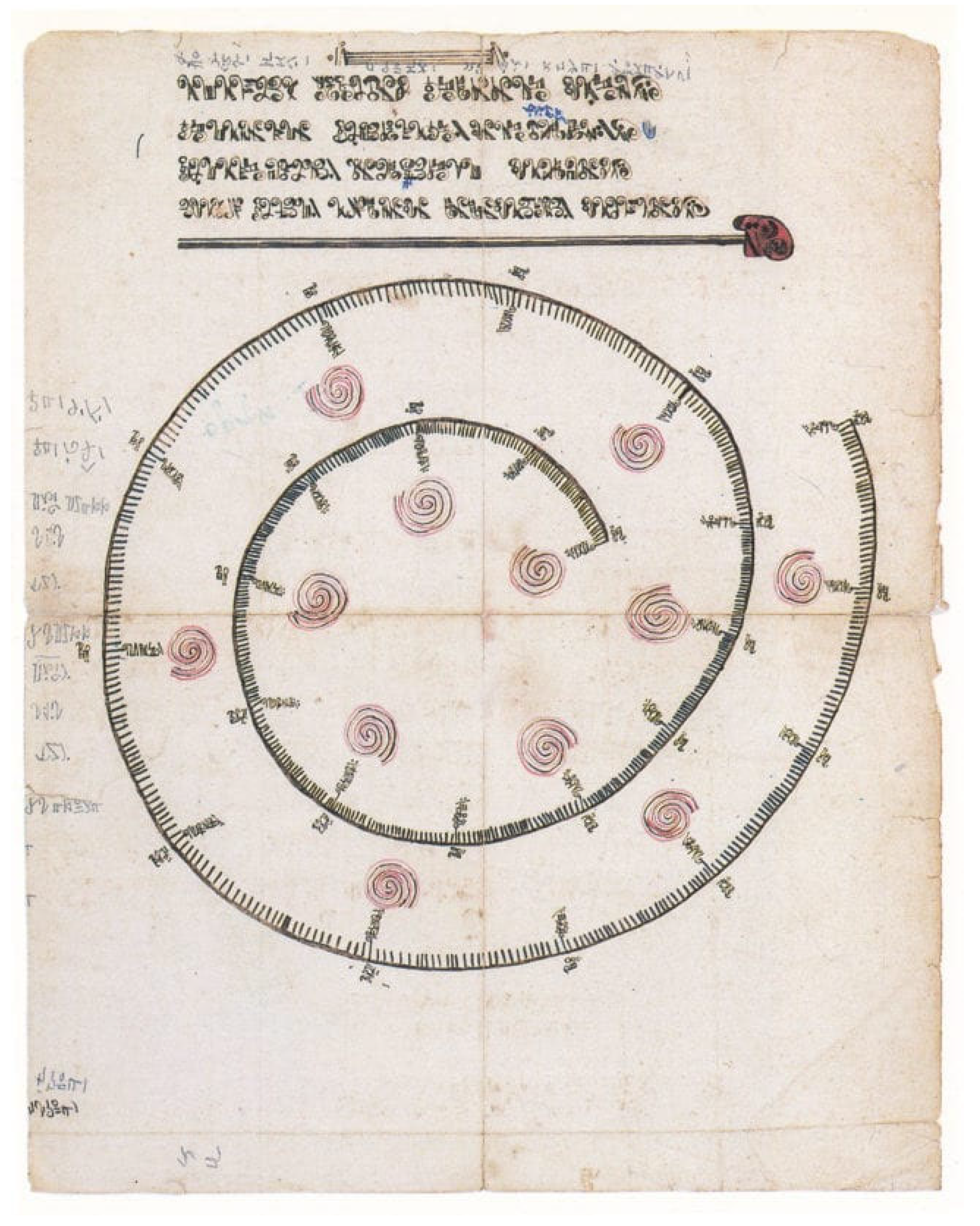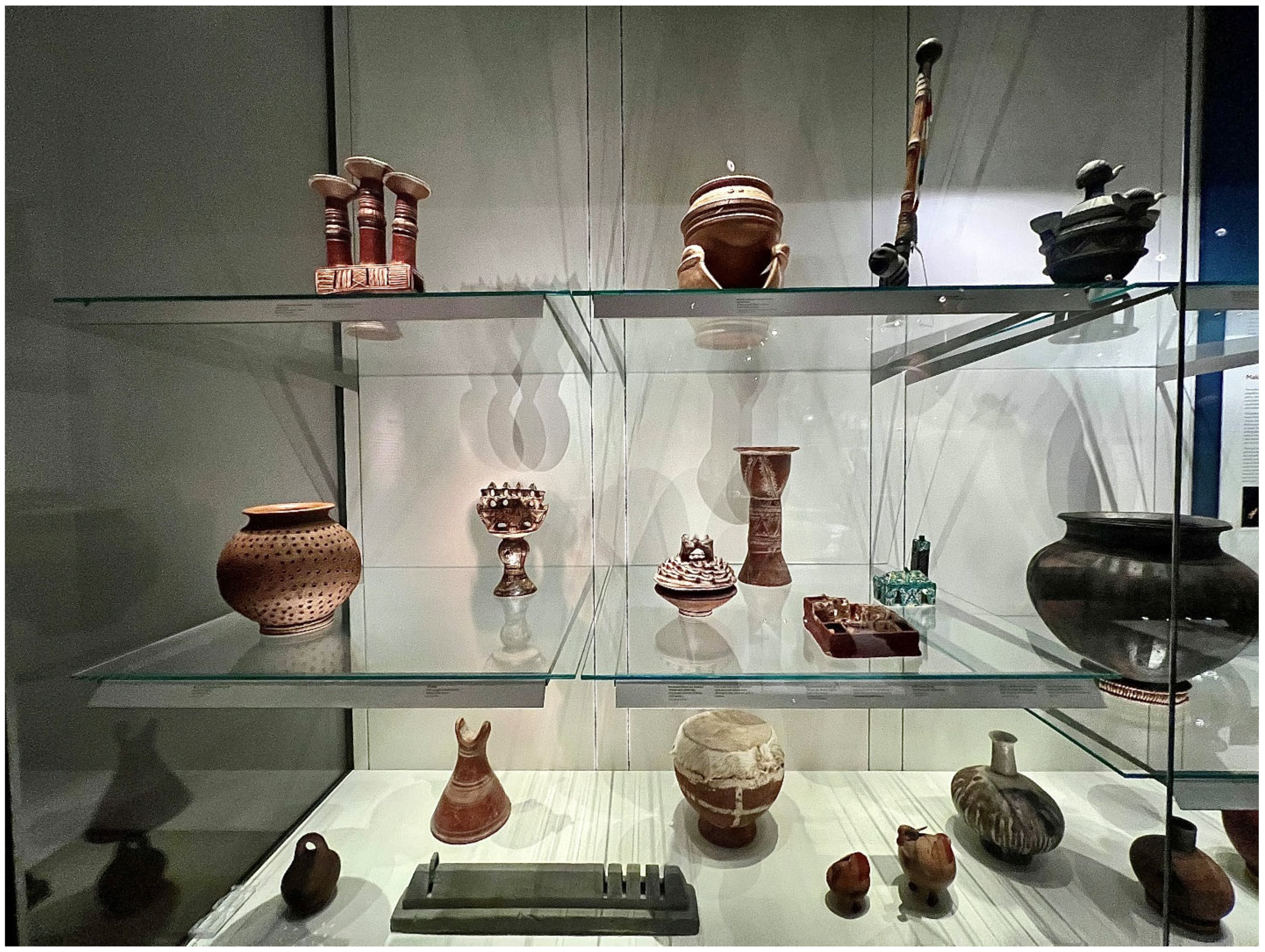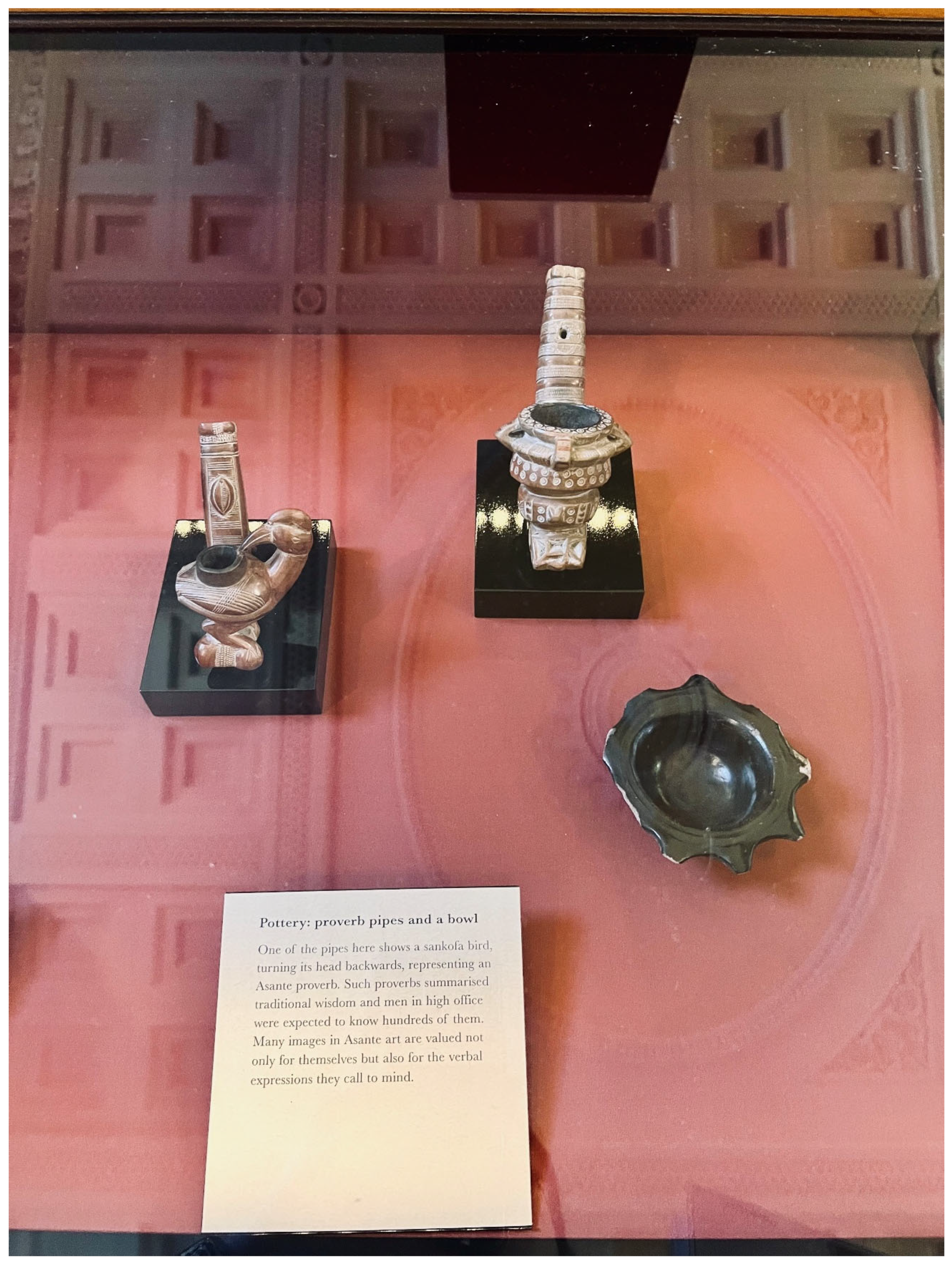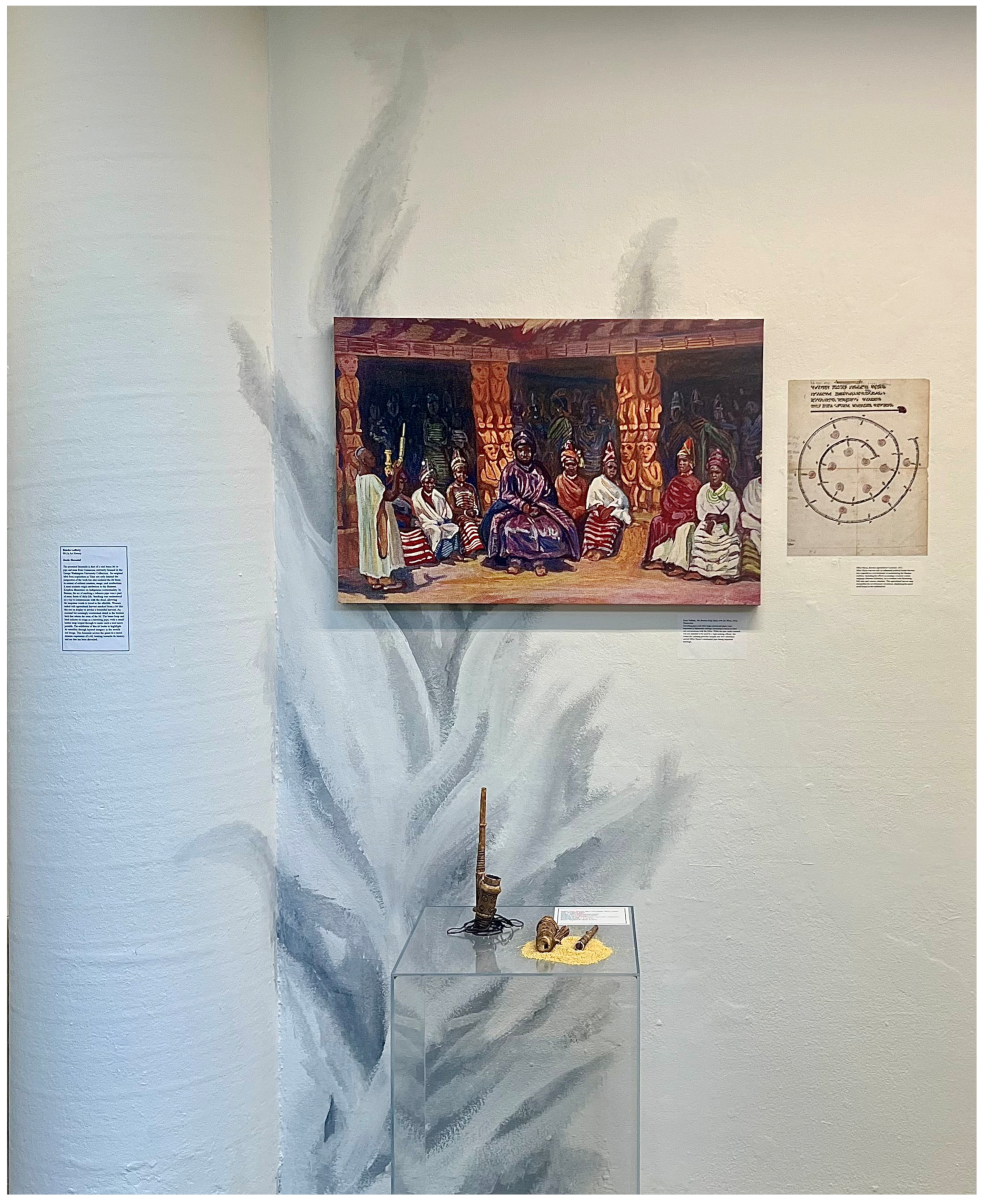1. Introduction
Trapped behind planes of glass in reenvisioned cabinets of curiosities, many African pipes are displayed out of context and objectified for aesthetic contemplation. They are callously exhibited together with “similar” objects and imagery regardless of cultural origin, symbology, or significance, extending museal violence against the continent in 21st-century museums. The African continent is home to many ethnic groups, each with different values and beliefs. To label one cultural object as part of another region, as insinuated through exhibitions, without proper research into the heritage of the object, repeats a rhetoric of colonial dominance and misrepresents African cultures and peoples. Yet this is ongoing in many ethnographic and art museums throughout Europe and the US. Each region of Africa holds a tobacco pipe and the act of smoking a pipe in different esteem. Exhibited pipes can become offensive to the culture of origin if these cultural particularities are ignored, which ultimately perpetuates a power imbalance and undermines their spiritual and cultural significance. For many decades, these objects have been labeled as curiosities to be collected and oddities to be exploited in Western institutions. With the current debates about reforming museums, these traditional practices need to be discarded urgently.
Today’s academic discourse on African art centers on fetishized masks and spiritual objects (
Silva 2017, p. 79). Yet these conversations tied to the issues of restitution and repatriation cease when topics shift to more utilitarian objects, such as the tobacco pipe and its trivialized display in Western spaces. The dialogue surrounding the restitution of African material culture is not linear and often falls into a gray area, but that does not make it any less important to address. Yet, it does not cover the colonial museumization of objects, such as pipes. This research examines an acquired pipe in the George Washington University collections (
Figure 1). This paper looks to argue that this pipe should be reidentified as a kii from Bamum, intended as a traveling object for a female or low-ranking official in the Bamum court, based on its geometric motifs and materials. The future of the object in the collections is contingent on what the Cameroonian people demand of their material culture; however, at the current time, there is no harm in ethically displaying the kii—but such display must be accompanied by robust contextualization.
This pipe is currently labeled in the university database as originating from the Tikar ethnic group, based on the acquisition papers from the 1975 donation documents (
The Brady Gallery 1975). Proper research begins to question this attribution, demonstrating how collectors’ provision of wrong and insufficient information contributes to the current misrepresentation of African material culture in so-called universal museums. This object was donated to the collection by a Floridian lawyer who amassed a vast collection of African material culture and gifted them to various institutions across the United States. George Washington University received a large donation from him in 1975, which featured another pipe, made from terracotta and depicting a figural relief (
Figure 2). The reason or method by which he collected African tangible heritage is currently unknown. Still, one thing is sure—he did not provide adequate contextual information about the object. It is this gap that provides the impetus for this year-long research in collaboration with the GWU Collection Museum staff.
The goal of this research is to accurately identify the object’s cultural attribution to the Bamum kingdom, its uses, and to propose an ethical framework for its display. The research adopts the Heritage Context Retrieval Analysis (HeCRA) method. This methodology is an anti-colonial approach to studying African material culture, to recover their origins and significance while also facilitating the development of ethical modalities for respectfully exhibiting the continent’s tangible culture (
Akpang 2025). HeCRA facilitates ethical restitution for non-contested objects in terms of context retrieval and display. Objects that, although not contested, are still used by museums to perpetuate violence against Africa. The process of HeCRA begins with a detailed formal analysis of the chosen object, then proceeds to a proper comparison of the object to others in the museum or collection holdings worldwide. This comparison constitutes the basis for establishing the object’s cultural attribution or solidified identity as well as cultural recontextualization. HeCRA facilitates the retrieval of tangible heritage’s cultural significance, including the rationale behind its creation, and the identification of its spiritual or ritualistic properties. This understanding can come from learning the use of the object or through the decorative motifs adorning the work itself. It is this methodology that provided the foundation for my intervention for an ethical solution for this kii.
By employing this research method, it uncovers the actual Indigenous usage and meanings of the kii, rather than the perceptions placed on it by Euro-American institutions. This research lays the groundwork for further studies on the collected kii from Bamum to mitigate the unintentional harm that exhibitions have long inflicted on this tangible heritage. It not only reveals a proper recovered understanding of the function and purpose of a brass kii in an American collection but also raises ethical considerations about its handling, thus contributing to recent debates on museum reform. The paper further attempts to dismantle colonial biases in the recurring attachment to Cabinet of Curiosity mindsets in the display of kii in Euro-American museums.
The topic of museum collections and their dark truth is not new nor ending. Instead, it is persistent and ever evolving with both political discourse and ethical demands. Scholars open the discussion on current museum collections and their affairs with the repeated rhetoric of power imbalances. Art Historian Annie Coombes writes about the experiences brought by the British Museum at the turn of the twentieth century and their recreation of African identity to fit a narrative they were peddling (
Coombes 1997). Coombes dives into the consequences of imperialism, serving as the motivating factor for institutions claiming to preserve heritage. Sela Adjei and Yann LeGall further this in more global case studies with their 2024 “
Fifteen Colonial Thefts: A Guide to Looted African Heritage in Museums.” The authors reintroduce the topic of colonial looting and the collection of war spoils. This volume looks not only at the famously discussed or the publicly accessible cases, but also goes beyond into those locked away in institutions’ coffers. The collected essays provide individualized case studies to help the reader navigate the expansive nature of what ethical restitution means in the modern age (
Adjei and LeGall 2024), especially regarding separating today’s academia from the harmful ghosts of centuries-old traditions.
This paper addresses multiple facets related to this brass kii and any future exhibition of the object and/or similar tangible heritage materials. It begins by discussing the GWU Collection kii and proceeds to explore the cultural symbolism of kiis in the Bamoun kingdom. It then critiques the taxonomy of the cabinet of curiosities. The paper concludes by suggesting ethical approaches for displaying such objects, using a recent experiment in an exhibition titled “ONCE KNOWN” as a case in point.
2. The GWU Collection’s Kii
The object of focus is entirely made of brass, split into two sections that are likely joined together at the stem. The bowl of the pipe is adorned with ten spiral motifs that line the body in a two-by-five formation. Above and below this main body are diagonal grooves that mimic the appearance of foliage. The bottom portion of the bowl features concentric circles, and this imagery is repeated on the adjoining portion of the stem. A small brass loop is attached to the base of the bowl, with a matching broken latch appearing in the middle of the stem. On the base of the bowl is a small hole, likely placed during the manufacturing process for proper aeration of burning tobacco. The object appears bright in the burnished brass finish with a dark brown patina filling in the grooves. As it sits in collections today, the object is in two pieces; however, it is understood as one work that was joined together with a small piece of wood and beeswax.
The technique used to create this object is the lost-wax casting method, in which a wax model is first created by hand before being cast with molten brass. The molten brass burned away any wax before the metal quickly filled the space left behind (
Malcolm 1923, pp. 2–3). This makes each work a unique kind, as each model was created specifically for the owner, and models were destroyed in the process. The aforementioned Tikar ethnic group held mastery over this technique. They were seen as pioneers of the method in the region, with their ability to incise intricate details into the cast metal. While the detail and medium of the pipe can allude to its linkage to the Tikar group, this is more of an umbrella term used to connect multiple ethnic communities in Northwest Cameroon (
Fomine 2010, p. 111) The Tikar migrated throughout Cameroon, with various societies claiming a link back to the Tikar, such as the Bamum and Bamileke (
Malcolm 1923, p. 1). The Tikar do not have a fixed geographical location as they connect multiple sites. They are recognized as skilled artisans in Northwest Cameroon, while other ethnic groups assert lineage to the region to validate their artistic legacy.
Africa holds varied artistic traditions, yet their distinctions are overlooked due to the legacy of European ignorance (
Gebauer 1979, p. 29). The first step in identifying the work was to take a step back and solidify the connection between the studied pipe and Tikar. Emphasis was placed on geometric patterning on works, the medium of the pipe, and the specific head of the pipe. Objects from surrounding regions failed to match the set criteria, with pipes from the Congo (
Figure 3) and Nigeria (
Figure 4) becoming prime examples highlighting those discrepancies. Yet areas claiming lineage to the Tikar in Northwest Cameroon find themselves matching the descriptions sought out. This is especially seen with pipes claimed by Bamum (
Figure 5) and Bamileke. Early studies on the means of creating carved clay pipes showcase the same style of pipe bowl, matching it to the Cameroonian cultural traditions (
Jeffreys 1950a, p. 25). Bamum and Bamileke territories lend themselves to the possible location of origin; however, further exploration into pipe making in Bamum solidified its identity as a kii from the Bamum Kingdom. Bamum held brass casting in high regard, and brass was a prominent material used for making kiis. Brass casters were even seen as part of the inner circle of artisans for the leaders of the nation. They followed a set of traditions dictated towards the treatment of ornamentation for their works. Specific patterns and materials were for limited audiences. Geometric motifs, like that featured on the studied work coincide with similar imagery on pipes from the same regions found in German missionary collections. All of this combined evidence leads to the conclusion that the object housed in the GWU collection is a Bamum kii and should be appropriately identified as such. Due to the ambiguity surrounding the term Tikar, the database entry is incorrect and misleading. There is a need to accurately identify the origin of the kii in Cameroon by narrowing down the exact cultural context of its creation. Further discussion on the intended use and purpose of the kii is explored in the following sections.
3. Bamoun Kii and the Symbolism of Smoking
With a better understanding of the object under the new identity as a kii from Bamum, the focus shifts to recontextualizes the object with excavated knowledge that has been lost since its isolation in an American collection. What recontextualization means in this case is the provision of supplemental material to inform the viewer of the intended use and value of the object to the culture of creation. This shifts the paradigm of continued display of African material culture as spoils of war or “gifts” rooted in coloniality to a more ethical interpretation and understanding. Euro-American displays follow biased colonial beliefs about their collection, ignoring the cultural realities tied to these objects. By working to recontextualize African tangible heritage, their true identities and meanings will reemerge. The Bamum kii is a perfect case in point. Cameroon is characterized by diverse ethnic identities, each of which has its unique cultural laws and traditions. This means that to understand this kii, we must look at it in the context of what it is in Bamum. Smoking tobacco is an everyday activity in the daily life of the people of Bamum. However, it is not just a custom of daily life; instead, it maintains a spiritual connection tied to the image of smoke. It is believed that the rising of smoke is a way to communicate with the dead (
Homberger 2008, p. 41). As smoke rises from the physical form of the kii, their gradual disappearance through diffusion with air is believed to mingle with the spiritual realm of living ancestors. Through smoke, unspoken words are carried up into the sky to communicate with ancestors. Smoking also serves another purpose to promote bounty. In Bamoun, the harvesting of crops was tasked to women who would smoke from usually hand-carved kiis (
Mbaku 2005, p. 162). The combined notions of women as icons of fertility and smoke as a means of communication would invoke a prosperous harvest (
Mbaku 2005, p. 162). In this context, the kii becomes a medium for spiritually fueled smoke rising from the women of Bamum.
Establishing smoking tobacco as an essential practice in the kingdom is crucial to understanding the Kii’s place in the conversation on tangible heritage and ethical display. However, it is also important to note that the kii is the tool used to create smoke, not the spiritual object itself. It cannot be fetishized into a highly ritualistic object when it is not. The only type of kii that has a spiritual connection higher than that of a typical pipe is when it belongs to the Mfon of Bamum. The Mfon is the cultural and political leader of Bamum. The title is inherited through patrilineality, but the Mfon is aided by his mother or the na of Bamum (
Mcculloch et al. 2017, p. 55). As part of the ceremony to receive the title of Mfon, the individual is rubbed down with a poisonous oil to make them and their belongings untouchable by anyone other than themselves. Large brass ceremonial pipes with decorative beading are commissioned by Mfons and used daily at meetings. At the funeral of a Mfon, the last kii used by the leader is given to his descendant or the Njiamfa, then he is buried with a long-stemmed ceramic kii (
Jeffreys 1950b, p. 50). Other kiis belonging to the Mfon will be placed in the treasury of Bamum after he dies to ensure they are not used by anyone else. Within the community, brass casters or Ñgyii iyāp are held in high regard. They were not only tasked with creating the kiis for officials in the court but also maintained the traditions in their design. While the shape of the object leads to the location of Bamum, it is the motifs and materials that lead to the identification of the intended user of the object. Kiis are typically made from wood, clay, brass, and/or ivory, with the last two reserved for high-ranking officials and the Mfon. The medium used also points to the affluence of the individual purchasing the kii; if one had the means to pay for a commissioned brass pipe, they could own one. Wood and terracotta are options afforded to everyone, regardless of status, but are typically associated with female pipes. Women created their pipes, which they hand-carved and designed, inscribing their desires into the materials themselves through ideographs (
Gebauer 1972, p. 35).
As for the image on the kii, there is a hierarchy to what can be displayed on an individual’s kii. With this heavy burden of smoking, it comes as no surprise that the tools for such would be decorated. Everyone owned and used pipes; there were no restrictions on who could or could not. Instead, there were restrictions on the type of decorative motifs that could adorn the item. A pipe was an everyday object, serving a utilitarian and cosmological function more than an artistic one. Geometric patterning was allowed by anyone. The restrictions came with figural or zoomorphic details, as those were reserved for the Mfon (
Koloss 2002, p. 95). It is then up to the Mfon to decide if someone in his inner circle could employ those features on their pipes or other utilitarian objects. Lower-ranking officials may have carried elaborate brass pipes, but they could only feature geometric designs. This explains why historian Alison McKeating writes that highly developed artistic traditions of metalwork are deeply ingrained in the cultural and political institutions of the Bamum (
McKeating 1997, p. 94). This understanding reveals a possible lead to the ownership of the kii in the GWU collection due to the inscribed motifs.
A more notable finding from this research is the presence of a broken latch on the kii. At first glance, it could have been passed as decorative features that had broken at some point over the years, but further research into types of pipes led to a new answer—a traveling pipe (
Malcolm 1923, p. 2). A leather strap would be fastened to the pipe through the latches. Some traveling pipes were adorned with beadwork, a common artistic venture in Bamum. These features can be seen in images published by the Cambridge University Museum of Archaeology and Anthropology (
Figure 6). Such pipes were mainly reserved for the royals to carry when leaving and visiting surrounding areas. Pipes and smoking had their routines within diplomatic settings. The image of a pipe is associated with the king and his lineage, with statues of kings often depicted holding a pipe (
Malcolm 1923, p. 3). Statues representing the leader, Mfon, included three objects that automatically created an association with him. The calabash, or a gourd-shaped container for the sacred palm wine, a drinking horn for said palm wine, and a tobacco pipe (
Rudy 1972, p. 128). In Bamum, the Mfon, the most famous leader being Mfon Njoya (b. 1860–d. 1933), used a tobacco pipe to either draw out conversations or as an excuse not to talk to others (
Homberger 2008, p. 41). The kii becomes an extension of the Mfon, as mentioned above, where it is closely related to his image and authority. Ceremonial kiis are synonymous with the Mfon. When it comes to the rising smoke from kiis during diplomatic meetings, the smoke becomes the word of ancestors traveling into the air. This creates a sense of spiritual authority around the Mfon, and his word becomes the most important due to his rank and close association with spiritual elements. With the Mfon, smoking is not a vice, but rather a direct way to invite the deceased into conversation. When traveling, the Mfon brought attendants and his wives with him. Many of the attendants were tasked with carrying the large ceremonial pipes into diplomatic meetings, as seen in a watercolor painting of one such meeting by German artist Ernest Volbehr (
Figure 7). The ceremonial kiis are there to draw attention to the Mfon. This setting transforms them beyond the utilitarian tool that the kii in the GWU collection is.
There is a visual library of motifs for kiis created in Bamum, with pipe makers creating a symbolic dictionary for the repeated imagery found on kiis. The kii in the George Washington University collection features only one distinct motif, that of the spiral. Spirals are universal ideographs, with each global culture incorporating them into its material culture for cosmological and spiritual purposes. In the African continent, it is linked to Ancient Kemet and sacred geometry as well as wealth and the ndoro spiral of Zimbabwe (
Chazuzu 2021, p. 19). In Cameroon, the image of the spiral is associated with the cyclical concept of death and resurrection, that the nature of life is never-ending. The prominent
Reunification Monument is created in the shape of two intertwining spirals as recognition of the union of the two Cameroons—the Anglophone and Francophone (
Fon 2023). This is further exemplified by the appearance of the spiral in Bamum, both through illustrations and written language.
When Mfon Njoya took power, he worked to modernize the traditions of his kingdom (
Orosz 2025, p. 50). This included illustrating folktales and creating a written language, known as the Bamum Syllabary or Sho-Mum (
Fomine 2010, p. 116). African written and graphic systems became a part of the literacy and history of the region. These graphic systems bridge the gap between oral and written communications (
Mullen Kreamer et al. 2007, p. 79). Symbols are powerful and evoke strong messaging without needing the written work. This is the case with the image of the spiral. The likeness of the spiral appears eight times in the letters of the syllabary and is showcased in Mfon’s illustrations of folktales and calendars. In a 1911 agricultural map created by Mfon Njoya, the timeline takes the form of a large spiral, with important markers indicated by smaller double spirals (
Figure 8). This calendar creates a reference to the spiral, relating it to harvest and agricultural events in Bamum. This theme becomes relevant in light of the spiritual connection to smoke, which is believed to bring a prosperous harvest. This kii is the culmination of two symbols of bounty: fertility and affluence. The spiral motif alludes to the intended owner being associated with all forms of prosperity. The reference to the inscribed spiral and design choices indicates that its identity is a kii for a low-ranking official or even a wife of the Mfon who traveled with him on diplomatic missions (
Bauer 1989). This kii was a personal tool of the owner but is loaded with the weight of cultural references to prosperity and wealth. Locating this pipe in Bamum cosmology and kingdom reveals that what may appear as simple and utilitarian embodies dense meanings and context, which are often lost in museums’ obsession with the cabinet of curiosities.
4. Bamum Kii and Museums’ Cabinet of Curiosities Problem
Many current displays of kiis and other African tobacco pipes isolate them from their context and meanings and are given a status that disregards their original intentions and significance. Most institutions place pipes into large display cases surrounded by objects with little to no relevance to them, thereby recreating the problematic colonial taxonomy of the cabinet of curiosities. Originally referred to as Wunderkammern, these spaces were designed to show off the wonders of the natural world. From animals to minerals, objects were displayed to highlight human curiosity about the world around them. However, from the start, these collections “represented the wealth of their predecessors and their power over the natural and human world” (
Daston and Park 2001, p. 19). There was an implied otherness with the early appearance of these cabinets, with the discourse taking place between the East and the West. Where Eastern cultures became rivals and adversaries to Western ideals. This became the prelude to the treatment of African culture that came in the following centuries (
Daston and Park 2001, p. 26). As these collections grew, it was no longer just about the display of foreign objects of the natural world. These collections were transformed into habitats for studying materials derived from these So-called new lands and for scrutinizing the cultural differences. The intention was to create an implied comparison between the culture housing the work and the culture being examined.
A significant shift occurred during the Renaissance, as individuals began to seek different things for their cabinets. No longer was it limited to what they defined as wonders, but rather, they soon turned towards their viewpoint of the grotesque. In simple terms, they were “monster-hunting”; accumulating treasures of horror to show in their collections (
Daston and Park 2001, p. 173). Such themes were not confined to just documentation or portraits of individuals with birth defects, but also physical proof of such. These cabinets of curiosities transformed into a means of dominance and curated the physical display of otherness where objects of foreign lands and minds were nothing more than items to prove their superiority over. Where the implied otherness was recognized as this animalistic feature that separates them from the ‘refined’ European standards. This is the tradition that current museum curators and professionals in the field seem keen to avoid.
Today’s museums, like the Pipe Museum in Amsterdam, place kiis in the same space as other African pipes as well as European pipes. These objects are forced into a new narrative, where they acquire symbolic meaning as other tools, while actively erasing their context beyond the Euro-American recognition of tobacco pipes as a tool for a vice (
Macdonald 2022, p. 9). An opposing, yet still incredibly harmful, display of pipes is seen at the British Museum in London. The museum holds a vast collection of African pipes, as well as a wealth of African material culture. With that many objects, it was shocking to find three on display in the entire institution during my research visit in April 2025. One is located in the African exhibit on the lower level, and it is placed on the top shelf of a display surrounded by terracotta pottery. Its label offers no insight to the use or meaning of the object, only providing its attributed origin to Sudan (
Figure 9). There is no information on whether the objects surrounding the pipe are sacred or secular as well as coming from different regions, leading the viewer to assume that the African works have no cultural importance. This becomes problematic as it forces the viewer to assume the role of the Sudan pipe based on their previous experience of other objects in the vicinity. This pipe is removed from all cultural ties or materials that can inform the viewer of its use and value in Sudan. Effectively isolated from its Sudanese context, it recontextualizes the object into an identity that fits the museum’s narrative. This object becomes decontextualized by its display alongside terracotta bowls and pots, showcasing a utilitarian purpose, without providing information on the cultural values associated with smoking or tobacco. Furthermore, it does not speak to whether the imagery on the pipe alludes to something spiritual, cosmological, or tied to kingship. This display creates a new identity for each object in the case, without care for cultural fidelity. They are forced into a relationship when one does not exist. The only shared characteristics are their continent of creation and the medium of terracotta.
The most harmful display comes with the exhibition of two other pipes in the British Museum. Located on the main floor in Room 1, the gallery is curated around the theme of “Enlightenment” and creates a space reminiscent of a library or study from that period. This gallery is transformed into a large Cabinet of Curiosity. In this space, the foreign and exotic are showcased to bolster the owner’s status (
Macdonald 2022, p. 10). Objects from other countries and cultures line the walls and are displayed in cases throughout the rooms. One display case features a simple sign of “Africa”, showcasing two Asante pipes (
Figure 10). The small label in the case refers to the figure of a Sankofa bird that one pipe takes the shape of, as well as its spiritual meaning in Asante culture. This display lacks an in-depth examination of the object, isolating it from any spiritual or cultural context. This active disregard for deeper understanding and proper display is done in a way that perpetuates a tradition based on power imbalances (
Kassim 2017).
The British Museum has been a long-studied and mentioned institution when it comes to displaying colonial violence with its exhibitions. The prime case of this is with the Benin Bronzes and their relocation from the Benin palace to the British Museum after the Benin Punitive Expedition of 1897. These reliefs, as well as a multitude of sacred objects, were looted from the ruins caused by British forces. A driving force behind the collecting of these works was to destroy the cultural identity of the kingdom they were conquering (
Hicks 2020, p. 135). By maintaining the works of foreign nations they dominated, the British forces rewrote the narrative on what the works meant and ceased the existence of their cultural importance with such censorship. Works like the Benin Bronzes, whose history of acquisition is stained with blood and shadowed with violence, prioritize the return of the objects. However, in the conversation of utilitarian works like that of a Bamum kii, the same is not said. Kiis were often gifts between parties or even purchased during an individual’s travels. The accessibility and prominence of a small, personal kii in the daily routine of Bamum citizens proves that it does not share the same significance as ceremonial kiis of the Mfon, or even the Benin Bronzes.
Museums are not neutral spaces. They are deeply ingrained in imperialist mindsets. From the documentation to its treatment for public consumption, it is designed to “deny, retreat, and forget the reality of this acquisition (
Kassim 2017). In their process of feigning neutrality and innocence, they are active in their compliance with violence. If museums are to disentangle themselves from colonial violence and museology, there is an urgent need to rethink the display taxonomy of this cabinet of curiosities. Daston and Park’s quote says it best in terms of these displays and the forceful isolation of material culture. “Ignorance of causes produced wonder; one way to neutralize a wonder was to explain it” (
Daston and Park 2001, p. 333). The curiosity about the unknown was more valuable to the individual’s power than revealing the object’s cultural integrity.
5. Ethical Display as Restitution and Anti-Colonial Intervention
These exhibitions of African tobacco pipes highlight the shortcomings of modern institutions in their handling of non-Western tangible heritage. Museums attempt to reshape the understanding of an object to fit their ideal of what it should be, rather than creating a display that highlights the original context of the objects. Museums use what is familiar to the viewer in their taxonomies, forcing works to assimilate with unrelated objects. At the same time, maintain a level of exoticism to play into a viewer’s desire to experience misconstrued “otherness” (
Karp 1991, p. 13). They continue to prioritize viewer consumption over contextualizing cultural objects with fidelity to their origins. For the kii in the George Washington University collection and its future display, an opportunity to reject these colonial-oriented displays emerges, and it is our duty as scholars and curators to utilize such. The research for this object stems from a larger three-year project on redefining restitution, repatriation, and ethical display in the face of increasing demands on Western museums and institutions to rethink their collections. Discussing what comes next is necessary in terms of how scholars need to approach the future if we are to challenge the harmful notions of the past that remain ingrained in museums.
The handling of this kii and similar ones must align with the status it is afforded by Bamum culture. This means that it cannot be exhibited in direct conversation with highly ritualistic objects, such as masks or sacred royal figures. This is not to say that a kii is not as important as such objects, but rather to do so will mean neglecting its identity as a secular tool and elevating it to a status that it should not receive. This will alter the meaning of a kii, changing its understanding outside its original context. When placed in contact with a mask, it fetishizes the kii whilst simultaneously diluting the messaging of a spiritually significant object. Individualized research needs to be emphasized when displaying any cultural object. The exhibition of a kii must match its utilization as a secular tool in the daily life of the Bamum people without overtly ritualistic association. It must also reject the tradition of the Cabinet of Curiosities as a baseline for display that has been perpetuated for centuries in the Eurocentric objectification of non-Western cultures. In keeping many of the existing exhibitions of African material culture, we are enforcing “brulality that is refreshed every day” (
Hicks 2020, p. 137). Rejecting the current modalities of display will help bring an end to the recurring harm caused by museums. This means that we must be more intentional in our curating and adjust the canon we have established. If we do not, we become complacent about the harm that follows.
GWU is not the first educational institution to explore what lies ahead with museum displays and imbuing its collections with recontextualized information. The Broad Art Museum at Michigan State University held an exhibition from October 2015 to March 2016 titled “Immediate Things: Material Culture from West Africa”. This exhibition sought to give agency and identity back to works housed in their collections (
MSU 2023). With supportive material as well as explorative research into the histories of the objects, “Immediate Things” shows the viewer how the removal of these works and their supportive material can alter the state and value tied to them. With their use of facsimiles and contemporary understandings, the exhibition is a good example to reference when contemplating the individualized display of tangible heritage like the Bamum kii in the GWU collection.
Following extensive research into this kii, it explores the possibilities of an ethical, anti-colonial display with my colleagues in a recent exhibition titled “ONCE KNOWN: Disentangling and Reimagining GWU’s African Tangible Heritage” at GWU Gallery 102, from 8 May to 9 June 2025. With the use of facsimiles of the Kii and supporting objects, this exhibition served as an experimental display and a basis for a later exhibition of the entire GWU African material collection, which was being researched as part of the larger project scheduled for the fall of 2026. “ONCE KNOWN” was an opportunity for an in-depth individualized curation of these objects, allowing visitors to discover untold stories about each tangible heritage. The show strove to display the objects in a personalized yet cohesive manner, explicitly curated to each object’s rich cultural context. As for this kii, its display highlighted its use as a tool open to anyone who can afford it, while showcasing the importance of smoke. The motif of the spiral, as a connection to the Bamum agricultural world, as well as the use of smoke in diplomatic meetings, was also engaged. Two facsimiles were 3D printed, one remaining in two pieces and buried in millet, while the other was glued together into a single whole object and displayed upright. They were placed on a free-standing pedestal with smoke painted on the wall behind it, rising to the gallery ceiling. The smoke connected a canvas print of Volbehr’s watercolor painting and Njoya’s harvest calendar (
Figure 11). Each had accompanying labels to contextualize their connections to the kii, enriching viewers’ experience and understanding. This experimental display served as a trial run for the major exhibition, which is part of a three-year-long project. Documentation of this display, as well as the research that informed its staging, constitutes the blueprint for all later endeavors towards GWU’s handling of this
kii.
The proposed display diverges from the Cabinet of Curiosity, similar to those found at the British Museum or the Rijksmuseum of Amsterdam. For “ONCE KNOWN,” the power is given back to the object rather than the perception of the object constructed by museum professionals. The use of a facsimile allows guests to have an intimate interaction with the kii. The supportive material helps contextualize the material culture within the original Bamum identity rather than American collection narratives. In the exhibition, the kii is not thrown together with pipes of other cultural origins or surrounded by unrelated objects. The display is individualized to showcase what the object is and how it was used, rather than creating a new identity for it through Eurocentric ideals.
Much of the discussion of African material culture aligns with the demands for repatriation from both the countries of origin and the guilty parties, in hopes of clearing their consciences. This occurs regardless of whether the nation of origin wishes to discuss repatriation. This research extends beyond repatriation to examine the issue of restitution. Repatriation is not a panacea for the root problem that African material heritage faces in Western museums (
Akpang 2024). Confrontation of the colonial roots must happen in museums and institutions, and the desire to sweep accountability under the metaphorical rug. Restitution must also involve delving deeper into collections and what they house, as well as how they present them. It must restore the object’s context, content, and meaning while determining its future, whether or not the object is contested. The cabinet of curiosity was based on making objects from foreign lands into these wonders as a way to showcase an individual’s wealth and “worldly-ness”. Where the works in collections are only provided with information about the owner and how they acquired the works rather than actual artists or artisans (
Karp 1991, p. 12). It gives the objects an implied sense of “otherness.” This separates foreign material culture, especially that of Africa, as specimens to be gazed upon rather than works of equal standing to Europeans. Repeating the rhetoric of these cabinets does not just imply complicity; it suggests an agreement with the dogma of degradation that seeks to elevate European traditions as having a surpassing authority over African nations and their heritage. The cabinets of curiosities served as a means to colonize the artistry of African culture, metaphorically dominating it by misconstruing narratives of their tangible heritage. This was never acceptable, and in the 21st century, it is high time to take action against it.
6. Conclusions
This paper explored research that aimed to uncover the untold stories of a Bamum kii and pointed out the flaws in the current cultural attribution of the object. It also addressed the discourse on ethical handling and the future of African tangible heritage in the 21st century. While giving back the title kii to the object begins the process of ethical restitution, art historians and curators must go beyond dismantling past centuries of neglect. The motifs on the kii, along with its intended uses, enhance our understanding of the object, which is not represented in museum displays. Through the identification of the spiral iconography and that of smoke emerging from the kii, in Bamum cosmology, it is evident that the object is culturally complex in meaning. The fundamental basis for a kii was for everyday smoke. All were invited to have a kii, and there were no limitations on who could own one; instead, it was the design that separated the owners’ status. Yet, the examination of this kii and its details suggests a specific use within the community for a lower-ranking official or a wife. This understanding arises from the geometric motifs rather than figurative elements, which connotes a lower status; however, the choice of brass as the medium showcases that the purchasing or commissioning individual had to have possessed sufficient wealth to afford it. Understanding this informs how to treat the object ethically.
Conducting this research does not yield a single, universal answer to the question of ethical display of material culture. Instead, it demonstrates that there cannot be a single solution to address the current or past problems in the displays of African collections. While the case study for this research is centered on a single object, a Bamum kii, it highlights the appearance of decontextualization in multiple museums that emerge with extensive research. Until the cultural identity of an object is understood, a plan for display and contextualization cannot take place. The ethical display of African material culture can only come from an institution’s ability and willingness to conduct extensive research into both the cultural ties and provenance. In terms of the kii in GWU’s collection, displaying the kii ethically requires the soul of the object to be imbued back into the object following research findings into its context. While the kii in this general case is an emissary for the owner to connect to the spiritual world, it is not a spiritual relic. Ethical displays of kiis need to highlight this fact, to dismantle the fetishization of African material culture.
In terms of this brass kii, it is essential to highlight the value it holds in the context of Bamum culture. Past literature invokes this object as an oddity, a foreign object to house. This work should not be labeled as solely an artistic venture. Instead, it holds cultural significance and a sense of individualism from its intended owner that dictates its creative impressions on them. That goes to say that the value of the kii is given by the person who owned it and/or its intended purpose. Western museums and ideologies are centered on the aesthetic nature of their collections, on how pleasing or intriguing a work is to the viewer. However, maintaining this perspective on this object does irreparable harm. The kii is devalued to an object that can be chosen entirely at random rather than with traditions of material and ornamentation set by the Bamum society. Ethical display of these kii, as well as other works of material culture, will reshape the consumption of the works and alter how viewers outside Bamum view them. They are no longer viewed through the lens of how Western experts stage them. A kii should not be considered a Western pipe, as its value in society is uniquely complex.
This means that museums must stop invoking the cabinet of curiosity, where multiple objects with little connection or relation are thrown together under one umbrella term, forcing them to be buried under the weight of expected perceptions. No longer should cabinets displaying objects from multiple regions together be the standard for museum displays if museums are to achieve ethicality. Scholars and museum professionals must recognize cultural significances and display them in a manner that reflects the work done in staging the exhibitions “Immediate Things” and “ONCE KNOWN,” which strove for ethicality. These works should not be isolated from their cultural settings and influence, whether that is done by separating them from other related material or placing them in conversation with works of little relevance.
The research for this kii is a stepping stone for understanding anti-colonial displays relating to tobacco pipes. The methodology for any conducted studies must be centered on the individual object rather than the general understanding of what a person wishes it to be. Centuries of skewed academic writings and problematic discussions have left actual knowledge lacking in the discipline. The debates surrounding African material culture aim to address these issues rooted in colonial histories and the expropriation of African cultural heritage. Still, they cannot be resolved with the mere call for the return of objects. We must consider ethical restitution for non-contested objects in terms of display as well. Dialogues must be fostered on what is being exhibited, as well as a deep understanding of the potential harm to the object’s heritage. In the case of this kii, there is no harm in correctly displaying it, as long as it matches the anti-colonial museological attempts made in the exhibition “ONCE KNOWN.”
African tangible heritage cannot continue to be displayed out of context without information to enlighten museumgoers. Ethics should guide curatorial decisions, concentrating on staging frameworks with the object’s fidelity to its significance in the source communities. Something that can be deduced from my research into a Bamum kii, ensuring its identity no longer remains shrouded in smoke.


